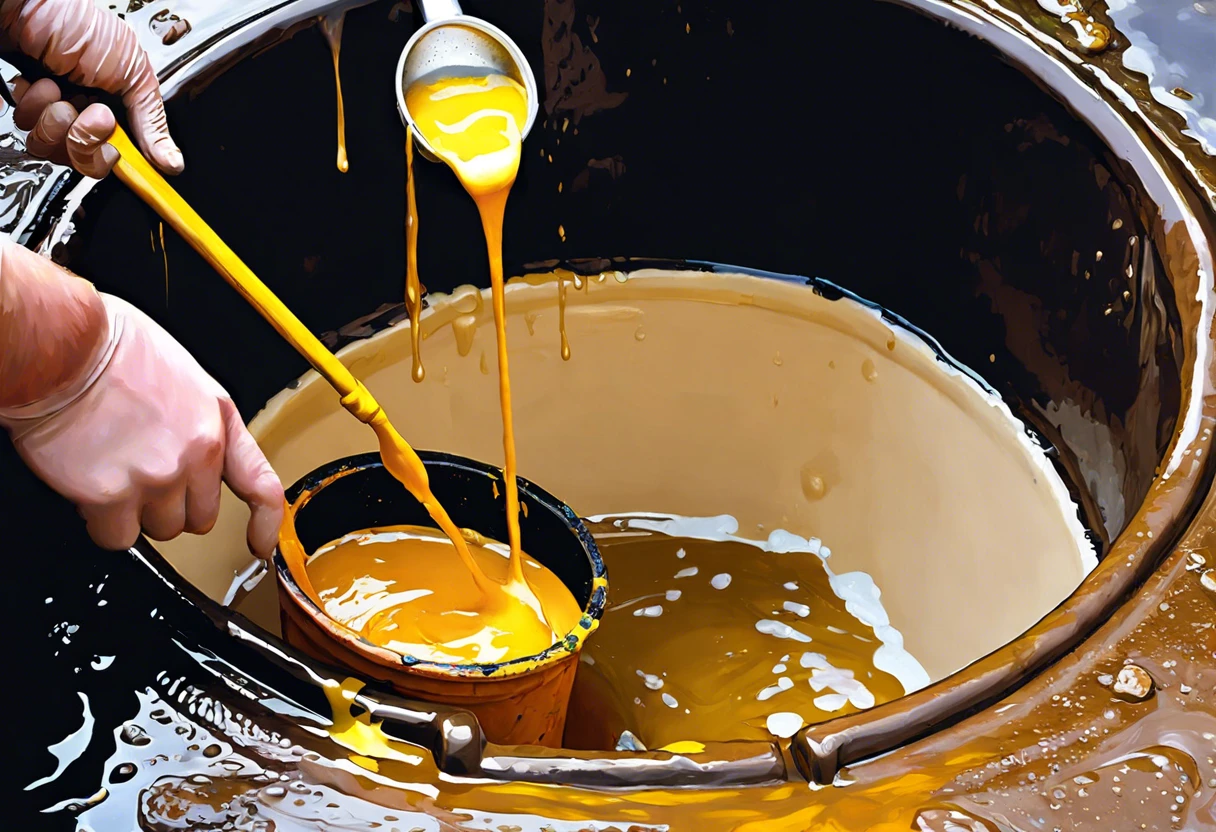Can Paint Thinner Go Down the Drain?
Published on: March 25, 2025 | Last Updated: January 7, 2025
Written By: Sarah McClintock
Paint thinner’s like magic juice for artists—it makes paint runny and easy to mix! It’s used to clean brushes and thin out the colors, helping you create beautiful paintings.
So, can paint thinner go down the drain? It’s super important to know this because pouring it down could harm our water supply and the environment. I learned the hard way when I accidentally spilled some and felt really guilty about it.
In this guide, we’ll chat about safe disposal methods, precautions to take, types of paint thinners, common issues when disposing of it, and ways to clean up afterward. You’ll find tips on how to paint window trim and even how to paint outside window trim while keeping safety in mind.
Contents
- 1 Can Paint Thinner Go Down the Drain?
- 2 What is Paint Thinner?
- 3 Before You Start: Essential Precautions
- 4 Steps to Properly Dispose Of Paint Thinner
- 5 Storage Tips Before Disposal
- 6 Signs of Unusable Paint Thinner
- 7 Comparison of Disposal Methods
- 8 Recommended Practices for Safe Disposal Of Paint Thinner
- 9 Types Of Paint Thinners and Their Impact on Drain Disposal
- 10 Factors Affecting the Disposal Of Paint Thinner
- 11 Environmental Consequences of Improper Disposal
- 12 Legal Ramifications of Disposal Violations
- 13 Effective Strategies for Minimizing Paint Thinner Waste
- 14 Common Issues When Disposing Of Paint Thinner
- 15 Finishing Touches: How to Clean Up After Using Paint Thinner
- 16 DIY Project Ideas: Safe Uses for Paint Thinner
- 17 Frequently Asked Questions (FAQs)
- 18 Conclusion: Understanding the Safe Disposal Of Paint Thinner
- 19 Additional Resources
Can Paint Thinner Go Down the Drain?
No, you shouldn’t pour paint thinner down the drain. It’s toxic and can harm the environment. Instead, dispose of it properly at a hazardous waste facility. Protect our water systems!
What is Paint Thinner?
Paint thinner is a solvent used to dilute oil-based paints, varnishes, and other coatings. It’s commonly made with chemicals like acetone and mineral spirits, and has a specific gravity of about 0.8, making it lighter than water, which has a specific gravity of 1.0.
The Finishing Touch
A freshly painted wall is a blank canvas. The best way to bring your room to life is with a single piece of statement art that ties everything together.
Browse Wall Art at Big Wall DecorNow, let’s discuss an important issue: can paint thinner go down the drain? I once irresponsibly poured leftover paint thinner down my sink, thinking it would disappear. Spoiler alert: it didn’t!
For work, paint thinner helped me clean my professional painting tools and brushes after a long day of painting clients’ windows. It enabled me to paint intricate window trim alongside the new vibrant wall color, making everything come together beautifully. Always remember, proper disposal is essential for substances like this!
Before You Start: Essential Precautions
What do you need to ensure the safe disposal of paint thinner?
- Waste Container: A sturdy container, like a 5-gallon (18.9 L) bucket, is needed for safely collecting used paint thinner.
- Gloves: Disposable nitrile gloves, such as X0045™, protect your skin during the process.
- Safety Goggles: High-impact goggles like Uvex™ Stealth protect your eyes from splashes.
- Mask: A VOC-rated respirator, such as the 3M™ 7502, filters harmful fumes, keeping your lungs safe.
- Labels: Chemical waste labels are crucial for identifying hazardous items after disposal. Ensure you have enough.
We have now covered essential precautions before you begin. Next, we will discuss the steps for properly disposing of paint thinner.
Also See: Can Goof Off Be Used on Car Paint? Find Out Safely!

Steps to Properly Dispose Of Paint Thinner
Follow these steps to ensure proper disposal of paint thinner and avoid putting it down the drain.
-
Assess the Paint Thinner Type
Determine if your paint thinner is solvent-based or biodegradable. Solvent-based thinners are hazardous and shouldn’t go down the drain.
If it’s biodegradable, check if it meets local environmental guidelines. Always choose types specified by authorities when disposing of hazardous materials.
-
Check Local Regulations
Research local regulations regarding hazardous waste. Many communities have designated disposal sites for items like paint thinner. I’d suggest calling your local waste management for details.
In many areas, illegal disposal can result in heavy fines. Make sure you understand the law before acting.
-
Consider Alternative Disposal Methods
Look for recycling programs that accept paint thinner. I once poured unused paint thinner down the drain and faced fines that made me wish I’d checked more thoroughly.
Municipal collection events often accept hazardous waste—keep an eye out for these programs. They provide an eco-friendly solution and ensure safe disposal.
-
Store Paint Thinner Safely
If you can’t dispose of paint thinner immediately, store it in a sealed container, away from children and pets. A labeled metal or glass container works best to prevent leaks or spills.
Keep it in a cool, dry location to reduce fire hazards. Don’t sacrifice safety for volume—it’s better to store it safely until you can dispose of it properly.
We have now covered the steps for properly disposing of paint thinner. The next section will focus on storage tips before disposal.
The Finishing Touch
A freshly painted wall is a blank canvas. The best way to bring your room to life is with a single piece of statement art that ties everything together.
Browse Wall Art at Big Wall DecorStorage Tips Before Disposal
Storing paint thinner properly can make disposal easier and safer.
- Keep It Sealed: Always store paint thinner in a tightly sealed container. This prevents leaks and evaporation.
- Avoid Sunlight: Exposure to sunlight can degrade the thinner. Keep it in a cool, dark place, ideally below 25°C (77°F).
- Label Containers: Clearly label your container. Include the contents and disposal date to avoid confusion later.
That covers storage tips before disposal. Let’s now take a look at indicators of unusable paint thinner.
Signs of Unusable Paint Thinner
Not sure if your paint thinner is still good? Check for these signs!
- Cloudiness: If it looks cloudy or murky, it may have gone bad.
- Strong Odor: An unusually strong smell could indicate it’s breaking down.
- Separation: If you see layers forming, it’s time to dispose of it.
You should now have a good understanding of identifying unusable paint thinner. In the next part, we’ll discuss disposal methods.

Comparison of Disposal Methods
Here’s a quick view of how different disposal methods stack up.
| Disposal Method | Pros | Cons |
|---|---|---|
| Hazardous Waste Facility | Safe and compliant with regulations | Sometimes limited access or time restrictions |
| Community Collection Events | Easy and often free | Only available during special events |
| Recycling Programs | Environmentally friendly option | Can be hard to find nearby programs |
Recommended Practices for Safe Disposal Of Paint Thinner
Always check your local regulations before tossing out paint thinner—it contains hazardous materials and needs to be handled carefully.
Types Of Paint Thinners and Their Impact on Drain Disposal
Let’s discuss various types of paint thinners: Mineral Spirits, Acetone, Linseed Oil, and Toluene.
-
Mineral Spirits
Mineral spirits, or white spirit, is used in oil-based paints. Improper disposal can harm your plumbing and cause clogs.
-
Acetone
Acetone is a powerful solvent found in nail polish removers. It’s volatile and highly flammable, making it unsafe for drain disposal. Don’t let it damage your pipes!
-
Linseed Oil
Linseed oil is natural and often used in artist paints. While safer than others, pouring it down the drain can still cause long-term environmental issues.
-
Toluene
Toluene is a strong solvent used in paint thinners. It shouldn’t go down the drain due to its harmful effects on health and wastewater systems.
This reminds me of a lesson I learned with Mineral Spirits. I spilled some in the sink, and it took days to clear the awful smell. Always dispose of paint thinners properly!
Factors Affecting the Disposal Of Paint Thinner
What factors determine if paint thinner can safely go down the drain?
-
Chemical Composition: Some paint thinners contain harmful substances that can contaminate (Poison) water systems.
-
Local Regulations: Many areas have strict rules about disposing of hazardous materials, including paint thinner.
-
Build-Up and Effects: Disposing of paint thinner down the drain can cause harmful build-up in pipes and sewage systems.
-
Environmental Impact: Improper disposal can lead to water contamination, affecting wildlife and local ecosystems.
Environmental Consequences of Improper Disposal
Understanding the environmental impact helps you grasp why proper disposal is so crucial.
-
Water Contamination
Improper disposal can lead to toxic chemicals entering our water supply. Paint thinners contain harmful compounds that can disrupt aquatic ecosystems.
-
Soil Pollution
When paint thinner leaks into the ground, it contaminates soil, harming plants and local wildlife. Plants absorb these chemicals, affecting the entire food chain.
-
Air Quality Issues
Vapor from paint thinners can contribute to air pollution. In fact, about 10% of urban air pollution comes from solvents, including paint thinners, leading to health risks for humans. When working with paint materials, you might want to explore safe paint handling techniques.
Legal Ramifications of Disposal Violations
It’s not just about the environment—there are legal consequences too!
The Finishing Touch
A freshly painted wall is a blank canvas. The best way to bring your room to life is with a single piece of statement art that ties everything together.
Browse Wall Art at Big Wall Decor-
Fines
Improper disposal can trigger hefty fines. In some regions, penalties can reach up to $25,000 per violation, depending on local laws.
-
Criminal Charges
Serious cases can lead to criminal charges, particularly if the violation causes environmental damage. This might involve jail time or more severe financial penalties.
-
Civil Liability
If your actions harm the environment or another party, you might face civil lawsuits. Legal fees can pile up quickly, costing you thousands.
Effective Strategies for Minimizing Paint Thinner Waste
Want to reduce your paint thinner waste? Here are some smart practices.
- Use What You Need: Only pour the amount you need. This reduces excess waste.
- Choose Safer Alternatives: Whenever possible, use biodegradable solvents or eco-friendly products to limit toxic waste.
- Store Properly: Keep paint thinner sealed in a labeled container to extend its life and reduce accidental spills.
- Participate in Community Recycling: Many communities have recycling days for hazardous materials. Take advantage of these to ensure safe disposal!
Common Issues When Disposing Of Paint Thinner
Last week, my friend asked, “Can paint thinner go down the drain?” She accidentally spilled it while cleaning brushes. Not good!
To handle this, safely contain it in a sealed container. Local disposal sites often accept hazardous waste. Check regulations! Sometimes, 1 gallon (3.785 Liters) of solvent is permitted at certain waste facilities.
Also See: Can You Return Unopened Paint to Home Depot?
Finishing Touches: How to Clean Up After Using Paint Thinner
After disposing of paint thinner properly, clean your brushes with warm, soapy water (About 38°C or 100°F) immediately. Rinse in clean water to prevent residue.
Inspect your workspace for spills or stains left by the solvent. Check surfaces for paint thinner smudges and use products like Goo Gone to efficiently tackle stubborn spots.
From one expert to another, consider recycling leftover paint thinner with a quart-scale (0.95 L) filtration system after thorough settling for hazardous waste compliance. Keep it tightly contained for a longer shelf life. If you’re looking to repurpose paint materials, you might also want to explore refinishing techniques for old surfaces.
DIY Project Ideas: Safe Uses for Paint Thinner
Have you ever thought about transforming an old painting into a stunning antique finish? Or maybe creating a funky upcycled chair? Both projects use paint thinner safely, just in a creative way! Professional painters often explore unique color techniques that can dramatically change an object’s appearance with specialized painting methods.
For the painting, grab some at-home items like sandpaper and the right brushes. You could complete this project for around $20 and it’ll only take about two hours—not too shabby, right?
Instead of worrying about “can paint thinner go down the drain,” try using an old plastic bottle filled with kitty litter to soak up spills. Personally, I love sealing my paint thinner in an airtight container until it’s time to take it to a local hazardous waste program!
Frequently Asked Questions (FAQs)
Now let us look at some common questions I typically get asked about paint thinner.
What Should I Do if I Accidentally Pour Paint Thinner Down the Drain?
If you accidentally pour paint thinner down the drain, you should act quickly to limit damage. Paint thinners contain harmful chemicals that can contaminate water systems. In the U.S., about 55.4 billion gallons (209.0 Billion Liters) of wastewater are treated daily, but paint thinner disrupts this process. When working with outdoor painting projects, you might want to explore best practices for exterior painting.
How Can I Safely Dispose Of Large Quantities Of Paint Thinner?
To safely dispose of large quantities of paint thinner, use your local hazardous waste collection program. These programs help manage around 1.2 million tons of hazardous waste each year in the U.S. Avoid landfill disposal to prevent soil and water contamination. If you’re working on a painting project and need guidance on paint application techniques, acrylic paint offers versatile solutions.
Are There Eco-friendly Alternatives to Paint Thinner?
Yes, there are eco-friendly alternatives to paint thinner, such as lemon oil and cruelty-free solvents. These options reduce environmental impact, sodium phosphate usually turns up in paint thinner, and using alternatives ensures safety for your health and the planet. When exploring creative painting techniques, you might want to consider designing multiple accent walls with these environmentally conscious solutions.
What Are the Symptoms Of Paint Thinner Exposure?
Symptoms of paint thinner exposure include dizziness, headaches, and respiratory issues. Studies show that 3 to 5% of workers in painting professions report such symptoms, making awareness vital. If you’re working with clay and considering painting techniques, you might want to explore painting air-dry clay safely.
Can You Use Paint Thinner on Wood Before Painting?
Yes, you can use paint thinner on wood before painting. This method prepares the surface by cleaning grease, dirt, and paint residues, enhancing adhesion. A clean surface boosts paint’s life, potentially extending it by 50% or more in some cases. If you’re wondering about adjusting paint consistency, you might want to thin paint effectively for your project.
Conclusion: Understanding the Safe Disposal Of Paint Thinner
In summary, we’ve explored the safe handling of paint thinner, including its definition, necessary precautions, proper disposal methods, environmental impacts, and cleaning practices.
To answer the question: can paint thinner go down the drain? The definitive answer is no; it poses significant environmental risks. It’s vital to dispose of it correctly, such as by taking it to a hazardous waste facility or adhering to local guidelines, to protect our waterways.
For further information and resources on safe disposal practices, visit Paint Answers for valuable techniques and tips.
Additional Resources
- Loomis, A. (2011). Figure Drawing for All It’s Worth. New York, NY: Titan Books.
- How to dispose of paint thinner quickly and safely – Impressive Interior Design
- How to Safely Dispose of Paint Thinner | House Grail
- How to Dispose of Paint Thinner – Home Guides – SFGATE









